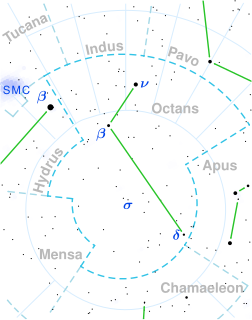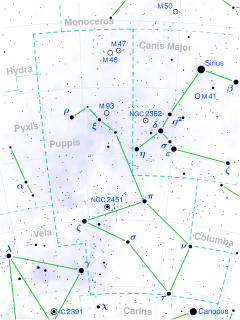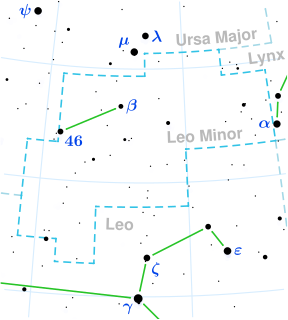
Epsilon Sculptoris is a binary star in the constellation Sculptor. It is approximately 91.7 light years from Earth.

68 Ophiuchi is a binary star system in the equatorial constellation of Ophiuchus. It is visible to the naked eye as a faint star with an apparent visual magnitude of 4.42. The system is located around 89.69 parsecs (292.5 ly) distant from the Sun, based on parallax, and is drifting further away with a radial velocity of +6 km/s.

ε Monocerotis, Latinised as Epsilon Monocerotis, is the Bayer designation of a binary star system in the equatorial constellation Monoceros. Its location is a guide for sky navigation toward the Rosette Nebula.

Epsilon Microscopii, Latinized from ε Microscopii, is a single, white-hued star in the southern constellationof Microscopium. It is faintly visible to the naked eye with an apparent visual magnitude of 4.71. The annual parallax shift of the star is 19.7054 mas as measured from Earth, which yields a distance estimate of around 166 light years. It is moving further from the Sun with a radial velocity of +7 km/s.

3 Monocerotis is a binary star system in the equatorial constellation of Monoceros, located approximately 780 light years away from the Sun based on parallax. It is visible to the naked eye as a faint, blue-white hued star with a combined apparent visual magnitude of 4.92. The system is moving further from the Earth with a heliocentric radial velocity of +39 km/s.

16 Persei is a single, suspected variable star in the northern constellation of Perseus, located approximately 121 light years away based on parallax. It is visible to the naked eye as a yellow-white hued star with an apparent visual magnitude of 4.22. This object is moving further from the Earth with a heliocentric radial velocity of +14 km/s. It displays a relatively high proper motion, traversing the celestial sphere at the rate of 0.224″ per year.

Beta Octantis, Latinized from β Octantis, is a probable astrometric binary star system in the southern circumpolar constellation of Octans. It is faintly visible to the naked eye with an apparent visual magnitude of 4.13. Based upon an annual parallax shift of 21.85 mas as seen from Earth, it is located about 149 light years from the Sun. It is moving away from the Sun with a radial velocity of +19 km/s.

Tau Ophiuchi is a multiple star in the constellation Ophiuchus, approximately 167 light years away based on parallax. Its two main components are two yellow-white main sequence stars, A, of magnitude 5.24 and class F2V, and B, of magnitude 5.94 and class F5V, orbiting each other with a period of 257 years and eccentricity around 0.77. A is reported as a spectroscopic binary with a smaller star of 0.29 solar masses orbiting it every 186 days. An additional component, C, has a separation of 100.8" and magnitude 11.28.

32 Orionis is a triple star system in the equatorial constellation of Orion. It has the Bayer designation A Orionis, while 32 Orionis is the Flamsteed designation. This system is visible to the naked eye as a faint point of light with a combined apparent visual magnitude of 4.20. It is located approximately 303 light-years away from the Sun based on parallax, and is drifting further away with a radial velocity of +18.6 km/s.

34 Persei is a binary star system in the northern constellation of Perseus. It is visible to the naked eye as a faint, blue-white hued point of light with a combined apparent visual magnitude of 4.67. The system is located approximately 540 light years away from the Sun based on parallax, but it is drifting closer with a radial velocity of −3.5 km/s. It is a likely member of the Alpha Persei Cluster.

HD 63922 is a class B0III star in the constellation Puppis. Its apparent magnitude is 4.11 and it is approximately 1600 light years away based on parallax.

HD 69142 is a class K1II-III star in the constellation Puppis. Its apparent magnitude is 4.44 and it is approximately 298 light years away based on parallax.

HD 70060 is a class A8V star in the constellation Puppis. Its apparent magnitude is 4.45 and it is approximately 93.4 light years away based on parallax.

HD 61330 is a class B8IV star in the constellation Puppis. Its apparent magnitude is 4.53 and it is approximately 360 light years away based on parallax.

HD 65810 is a class A2V star in the constellation Puppis. Its apparent magnitude is 4.61 and it is approximately 241 light years away based on parallax.

HD 53811 is a class A4IV star in the constellation Puppis. Its apparent magnitude is 4.92 and it is approximately 198 light years away based on parallax.
HD 190056 is a class K1III star in the constellation Sagittarius. Its apparent magnitude is 4.99 and it is approximately 291 light years away based on parallax.

43 Persei is a binary star system in the northern constellation Perseus. It is visible to the naked eye as a dim, yellow-white hued star with an apparent visual magnitude of 5.28. The system is located around 38.5 parsecs (125.4 ly) distant from the Sun, based on parallax.

Theta2 Microscopii is a class A0III star in the constellation Microscopium. Its apparent magnitude is 5.76 and it is approximately 390 light years away based on parallax. It is an Ap star, a chemically peculiar star with unusually strong metallic spectral lines.

41 Leonis Minoris is a single star in the northern constellation Leo Minor, located near the southern border with the neighboring constellation of Leo. It is visible to the naked eye as a dim, white-hued star with an apparent visual magnitude of 5.08. This object is located approximately 229 light years away from the Sun, based on parallax, and is drifting further away with a radial velocity of +18.5 km/s.









